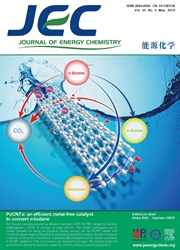

 中文摘要:
中文摘要:
Butyl levulinate(BL) is a promising new candidate as diesel fuel and fuel additive. In this study, an efficient process for a one-pot synthesis of BL from biomass-derived carbohydrates in butanol medium with the catalysis of metal sulfates was developed. The catalytic activity of a series of metal sulfates for the synthesis of BL from fructose was investigated. Among various metal sulfates, ferric sulfate Fe2(SO4)3 was found to be the most efficient catalyst, which gave a remarkably high BL yield of 62.8 mol% under the conditions of 463 K, 3 h, a catalyst dosage of 5.0 g/L, and fructose concentration of 25 g/L. Different carbohydrates including glucose, cellulose, inulin and sucrose were also used for one-pot synthesis of BL with the catalysis of Fe2(SO4)3, showing the yields of 39.6, 30.5, 56.6 and 50.1 mol%, respectively. In addition,the recycling and reuse of Fe2(SO4)3 was studied by characterizing them using powder X-ray diffraction(XRD), scanning electron microscope(SEM), X-ray photoelectron spectroscopy(XPS). A plausible reaction pathway for the one-pot synthesis of BL from fructose was proposed. This study provides a facile and feasible way for the synthesis of BL from biomass.
 英文摘要:
英文摘要:
Butyl levulinate (BL) is a promising new candidate as diesel fuel and fuel additive. In this study, an efficient process for a one-pot synthesis of BL from biomass-derived carbohydrates in butanol medium with the catalysis of metal sulfates was developed. The catalytic activity of a series of metal sulfates for the synthesis of BL from fructose was investigated. Among various metal sulfates, ferric sulfate Fe-2(SO4)(3) was found to be the most efficient catalyst, which gave a remarkably high BL yield of 62.8 mol% under the conditions of 463 K, 3 h, a catalyst dosage of 5.0 g/L, and fructose concentration of 25 g/L. Different carbohydrates including glucose, cellulose, inulin and sucrose were also used for one-pot synthesis of BL with the catalysis of Fe 2 (SO 4) 3, showing the yields of 39.6, 30.5, 56.6 and 50.1 mol%, respectively. In addition, the recycling and reuse of Fe 2 (SO 4) 3 was studied by characterizing them using powder X-ray diffraction (XRD), scanning electron microscope (SEM), X-ray photoelectron spectroscopy (XPS). A plausible reaction pathway for the one-pot synthesis of BL from fructose was proposed. This study provides a facile and feasible way for the synthesis of BL from biomass. (C) 2016 Science Press and Dalian Institute of Chemical Physics, Chinese Academy of Sciences. Published by Elsevier B.V. and Science Press. All rights reserved.
 同期刊论文项目
同期刊论文项目
 同项目期刊论文
同项目期刊论文
 One-pot production of a liquid biofuel candidate—Ethyl levulinate from glucose and furfural residues
One-pot production of a liquid biofuel candidate—Ethyl levulinate from glucose and furfural residues A comparative study on direct production of ethyl levulinate from glucose in ethanol media catalysed
A comparative study on direct production of ethyl levulinate from glucose in ethanol media catalysed Direct Conversion of Carbohydrates into Ethyl Levulinate with Potassium Phosphotungstate as an Effic
Direct Conversion of Carbohydrates into Ethyl Levulinate with Potassium Phosphotungstate as an Effic Direct production of levulinate from carbohydrates catalyzed by H-ZSM-5 supported phosphotungstic ac
Direct production of levulinate from carbohydrates catalyzed by H-ZSM-5 supported phosphotungstic ac 期刊信息
期刊信息
